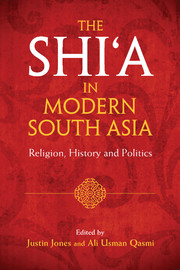Book contents
- Frontmatter
- Contents
- Preface
- Introduction
- 1 Faith Deployed for a New Shiʿi Polity in India
- 2 The Ismaʿili – Isna ʿAshari Divide Among the Khojas
- 3 Local Nodes of a Transnational Network
- 4 Shiʿism, Humanity and Revolution in Twentieth-century India
- 5 Universalising Aspirations
- 6 Muslims, Media and Mobility in the Indian Ocean Region
- 7 Shariʿa, Shiʿas and Chishtiya Revivalism
- 8 Third Wave Shiʿism
- Contributors
- Index
Introduction
Published online by Cambridge University Press: 05 May 2015
- Frontmatter
- Contents
- Preface
- Introduction
- 1 Faith Deployed for a New Shiʿi Polity in India
- 2 The Ismaʿili – Isna ʿAshari Divide Among the Khojas
- 3 Local Nodes of a Transnational Network
- 4 Shiʿism, Humanity and Revolution in Twentieth-century India
- 5 Universalising Aspirations
- 6 Muslims, Media and Mobility in the Indian Ocean Region
- 7 Shariʿa, Shiʿas and Chishtiya Revivalism
- 8 Third Wave Shiʿism
- Contributors
- Index
Summary
The Shiʿi communities of South Asia, roughly 60 million people, represent, after those of Iran, the second largest grouping of Shiʿas in the Muslim world. Until recently our knowledge of them has not matched their numbers. Indeed, they, and here I refer to the Twelver Shiʿas rather than the Ismaʿilis, have suffered from the paradox of being both highly visible but in scholarly terms largely invisible. Where the Shiʿa live in South Asian towns and cities, arguably, no community has been more visible or more audible: visible because of their great processions at Muharram; and audible, certainly at Muharram, but also throughout the year in their majalis, as they recount the events of Karbala, often transmitting them by loudspeaker to the muhalla.
Up to the 1980s these significant religious communities had attracted just two major works of scholarship: Hollister's, The Shiʿa of India (1936) and Engineer's The Bohras (1980). This dearth of scholarship began to change in the mid-1980s. First there was S. A. A. Rizvi's major two-volume survey of India's Twelver Shiʿas (1986), followed by Juan Cole's path-breaking study of the establishment of the Shiʿi state of Awadh from the eighteenth century (1988). From the 1990s attention turned to Shiʿi commemorative practice with Vernon Schubel's study of Shiʿi devotional rituals (1993), David Pinault's studies of ritual and popular piety (1992) and devotional life (2001) which were followed in similar vein by Toby Howarth's examination of Shiʿi preaching in Hyderabad (2005) and Syed Akbar Hyder's exploration of the role of Shiʿi martyrdom in South Asian memory (2006). Subsequently there have been two important studies of the Khoja Ismaʿilis: Marc van Grondelle's demonstration of the role of British imperial power in turning them into a successful transnational community (2009) and Teena Purohit's demonstration of how the Khoja Ismaʿilis were created in their particular Muslim form by the removal of pluralistic religious practices from their devotions (2012). The year 2012 saw Justin Jones' authoritative work on the creative responses of Lucknow's Twelver Shiʿas after the British brought Shiʿi political power to an end.
- Type
- Chapter
- Information
- The Shi‘a in Modern South AsiaReligion, History and Politics, pp. 1 - 11Publisher: Cambridge University PressPrint publication year: 2015



